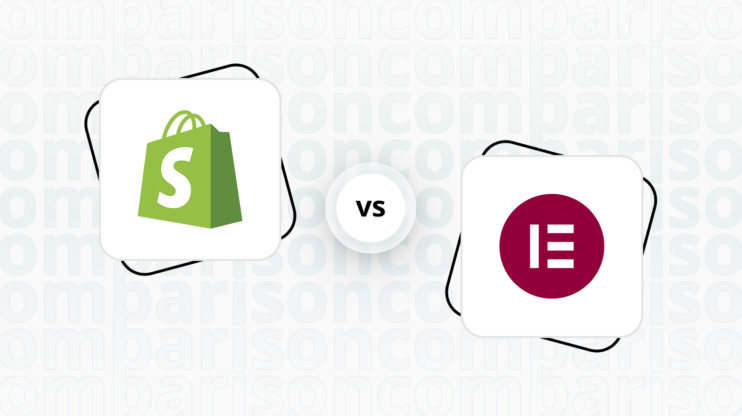Shopify vs Webflow: Final verdict
Shopify and Webflow both offer powerful website building solutions, but they cater to different user needs and preferences.
-
Shopify (Overall Grade: 8.1/10)
is a leading ecommerce platform, ideal for businesses looking to create and manage online stores with ease. It excels in providing comprehensive ecommerce features, advanced marketing tools, and robust security measures. Shopify’s user-friendly interface and extensive app ecosystem make it a top choice for online retailers aiming for growth and scalability. When comparing Shopify vs Webflow, Shopify stands out for its specialized ecommerce capabilities and seamless integration of sales and marketing tools. -
Webflow (Overall Grade: 7.9/10)
is a versatile website builder designed for professional designers and developers. It offers powerful design tools, a flexible CMS, and top-tier hosting services, making it a comprehensive solution for creating custom, responsive websites. Webflow’s advanced design functionalities and extensive customization options make it ideal for users seeking creative control and precision. In the Shopify vs Webflow comparison, Webflow shines with its robust design capabilities and flexibility, though it may present a steeper learning curve for beginners.

|

|
|
|---|---|---|
|
Design functionalities & templates |
8.2 |
8.6 |
|
Ease of use |
7.5 |
7.5 |
|
Ecommerce |
9.2 |
8.5 |
|
Website Editors |
7.9 |
9.0 |
|
Product testing options |
8.1 |
6.3 |
|
Price |
8.2 |
8.0 |
|
Hosting quality |
9.0 |
8.9 |
|
Website speed optimization |
7.8 |
8.1 |
|
Plugins and integrations |
8.7 |
5.5 |
|
Marketing features |
8.8 |
7.8 |
|
Customer support |
8.6 |
8.3 |
|
Security |
9.0 |
7.8 |
|
AI capabilities |
7.9 |
8.3 |
|
User Management |
6.5 |
8.3 |
Which one is the best for ecommerce: Shopify or Webflow?
 9.2
9.2
 8.5
8.5
Verdict
: Shopify is the superior choice for businesses focused on scaling and comprehensive ecommerce functionalities, while Webflow offers a robust platform for those seeking extensive customization and design flexibility.
-
Shopify
: With a score of 9.2, Shopify excels in providing a comprehensive set of ecommerce tools, including advanced inventory management, multi-channel selling, and detailed analytics. It is ideal for businesses looking to scale and manage a large volume of products. Shopify’s extensive app library and unique features like Augmented Reality further enhance its ecommerce capabilities. -
Webflow
: Scoring 8.5, Webflow is a powerful platform for creating highly customized online stores without extensive coding knowledge. It offers flexible CMS, responsive templates, and robust design tools, making it suitable for professional designers and businesses that prioritize design and customization. However, it may not match Shopify’s depth in ecommerce-specific features.
Which one is the best for informational and business websites?
 6.8
6.8
 8.6
8.6
Verdict
: When it comes to creating informational and business websites, Webflow outshines Shopify. Webflow’s advanced design capabilities and flexibility make it a superior choice for those looking to build visually appealing and highly customizable websites.
-
Shopify
: Shopify, with a score of 6.8, is primarily designed for ecommerce but can be adapted for informational websites. Its templates are sleek and professional, focusing on online stores. However, the platform’s ecommerce-centric features may feel excessive for simple informational sites, making it less ideal for this purpose. -
Webflow
: Scoring 8.6, Webflow is a robust platform for creating custom, responsive websites. It offers a wide array of design features and templates, making it perfect for informational and business websites. Webflow’s powerful design tools and flexible CMS allow for extensive customization, catering to professional designers and developers. When comparing Shopify vs Webflow, Webflow’s design flexibility and comprehensive features make it the preferred choice for informational sites.
Shopify vs Webflow: Detailed comparison
Design functionalities & templates
Design FunctionalitiesRepresents how well each platform allows for creative design and customization of websites.Score Components:
- Template Variety (30%): Range and quality of design templates.
- Customization (30%): Flexibility and options for design alterations.
- User Interface (20%): Ease and intuitiveness of the design process.
- Responsiveness (10%): Adaptability to different devices and screen sizes.
- Innovation (10%): Unique design features and tools.
 8.2
8.2
 8.6
8.6
🏆
Winner: Webflow.
If you’re looking for a platform that offers more creative control, a wide array of design features, and a diverse range of template and customization options, Webflow is the preferred choice.
Shopify’s templates are sleek and professional, ideal for ecommerce sites. They offer a sophisticated look with a focus on online stores. While the free template selection is not large, Shopify’s premium theme store provides a variety of industry-specific options, offering advanced features for a strong brand presence.
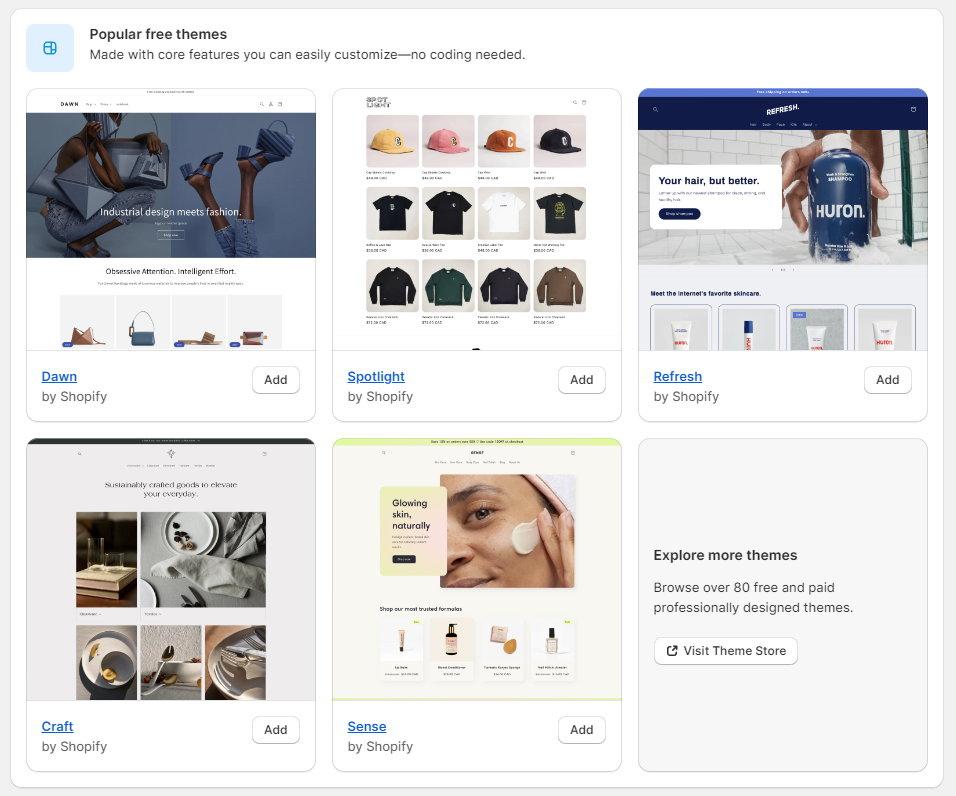
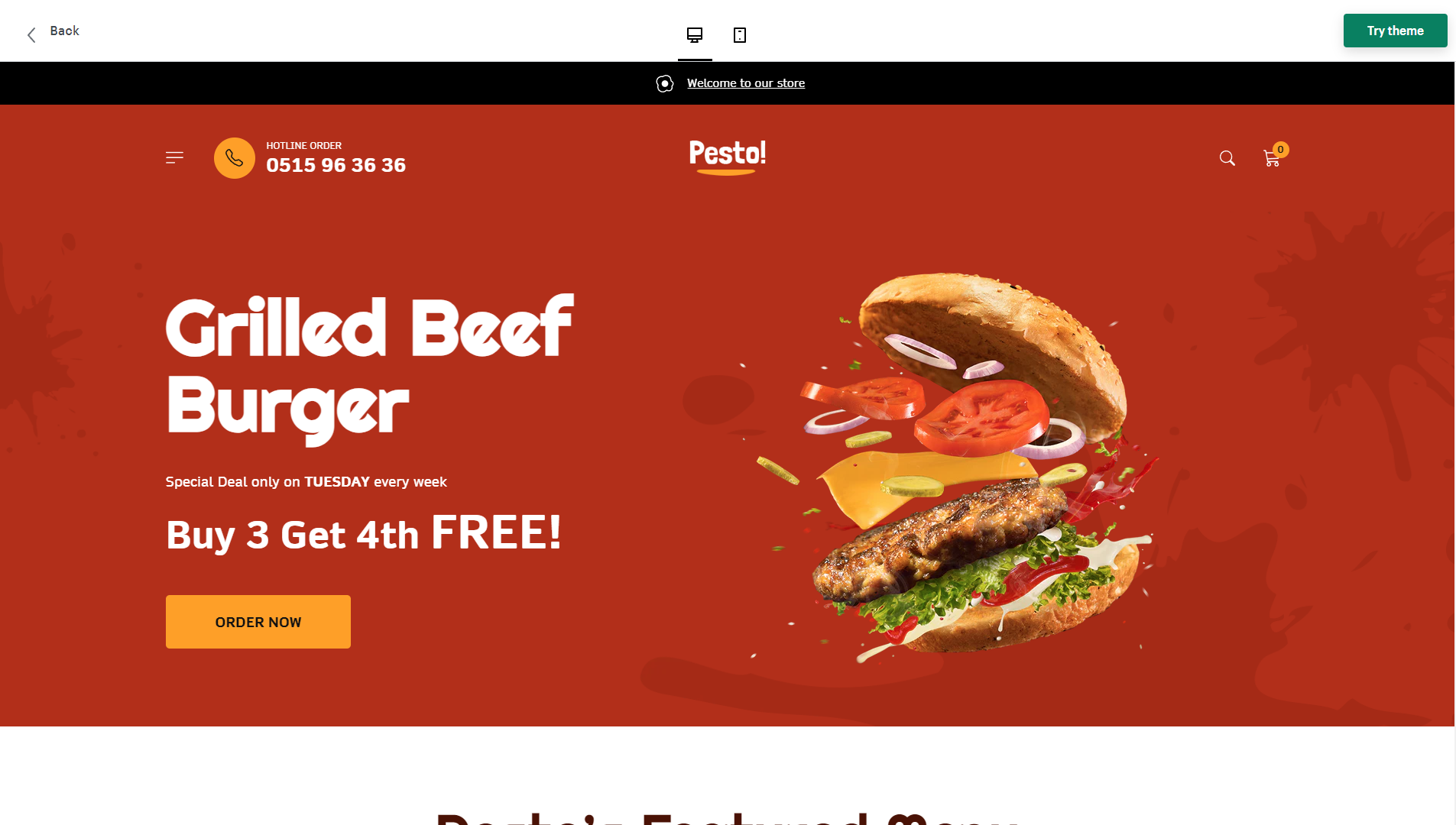
Compared to Shopify, Webflow delivers a robust design experience with a diverse range of template and customization options. Boasting over 1000 pre-built templates covering various industries and website types, including free and premium options, Webflow ensures a constantly evolving library for users. Templates are categorized for easy browsing, considering industry, website type, style, and features. The design customization features include a visual drag-and-drop editor for real-time adjustments, fine-grained control over every aspect of the design, and the ability to inject custom code for advanced users seeking additional personalization and unique functionalities.
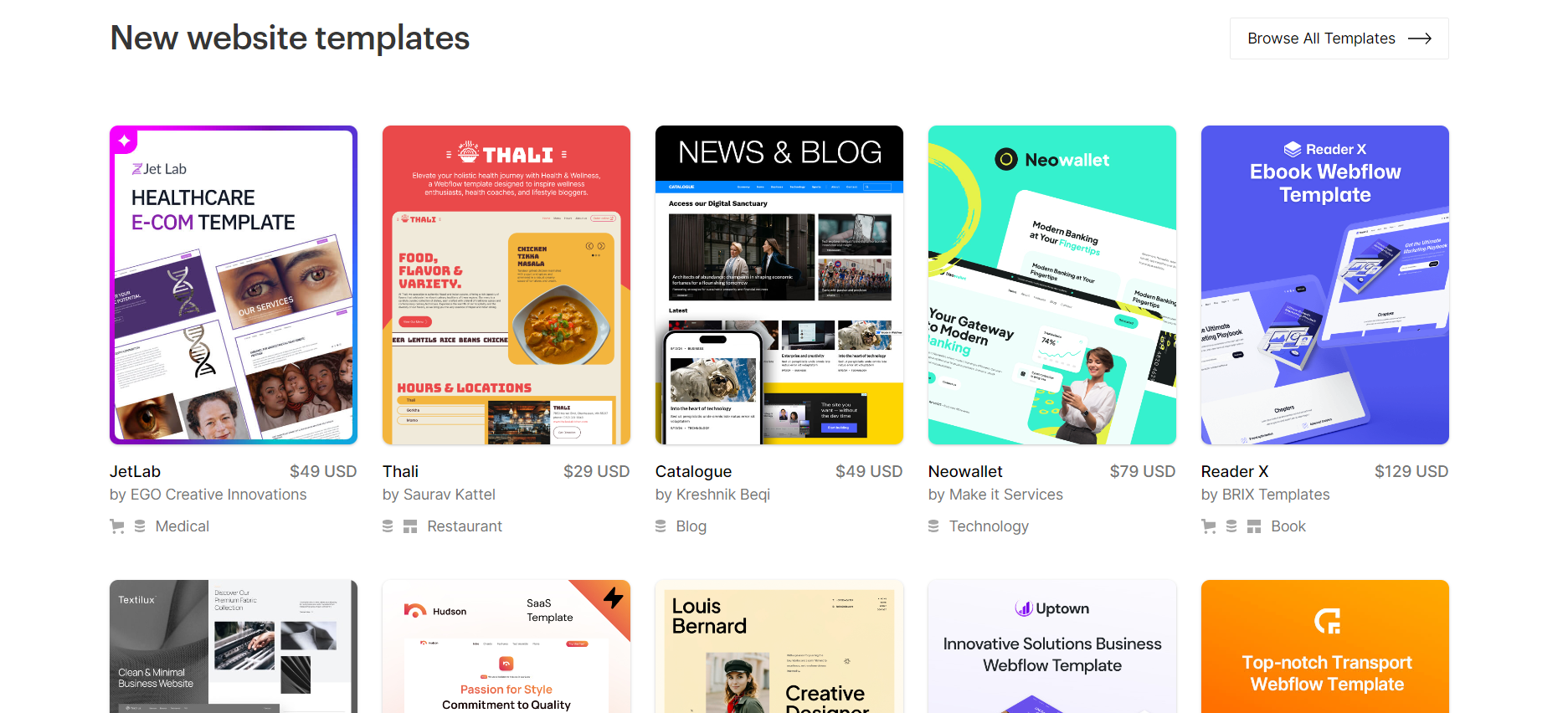
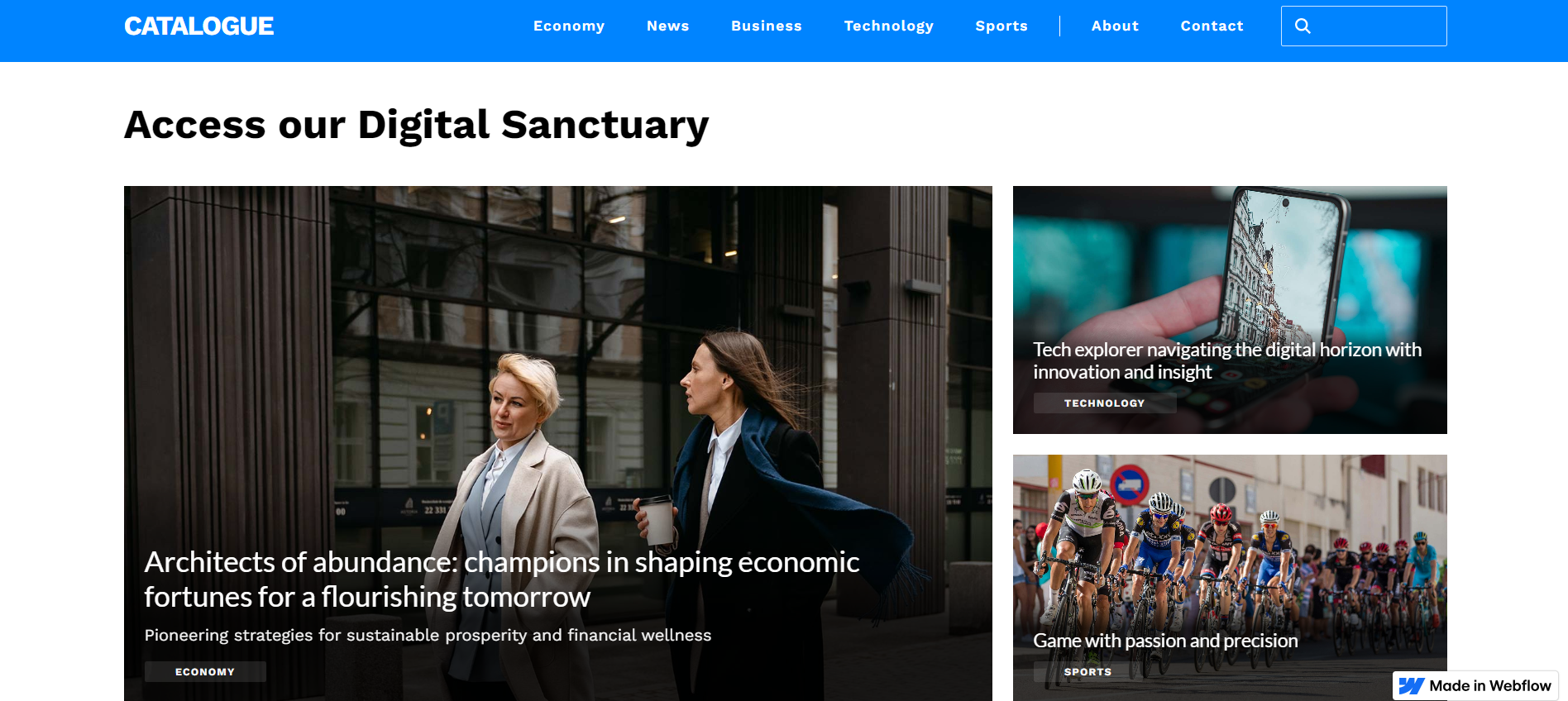
Get a head start on website creation with AI
Create a custom website tailored to your business needs 10X faster with 10Web AI Website Builder!
Ease of use
Ease of useReflects the platform’s overall user-friendliness.Score
Components:
- Learning curve (40%): Quickness and ease of getting started.
- Interface design (30%): Simplicity and intuitiveness of layout.
- User guidance (20%): Quality of tutorials and support.
- Flexibility (10%): Adaptability to various user skills.
 7.5
7.5
 7.5
7.5
🏆 Winner: Tie
. Both Shopify and Webflow scored 7.5 in ease of use. Shopify is praised for its user-friendly design and comprehensive support, making online store management accessible for all. On the other hand, Webflow is user-friendly for experienced designers and developers, offering a visually intuitive interface with drag-and-drop features. However, beginners may find it challenging due to a steeper learning curve.
Learning Resources
🏆 Winner: Webflow
. Both platforms offer solid learning resources, but Webflow goes a step further with its comprehensive set of learning resources for individuals seeking proficiency in the platform. Webflow University serves as an excellent starting point, delivering diverse courses and tutorials covering fundamental to advanced aspects of Webflow.
For ecommerce
EcommerceMeasures the platform’s effectiveness in supporting online business activities.Score Components:
- Ecommerce themes and templates (20%): Variety and design of templates.
- Product management (25%): Ease of managing and organizing products.
- Payment options (25%): Variety and convenience of payment methods.
- Ecommerce features (20%): Features for managing an ecommerce store.
- Integration (10%): Compatibility with external e-commerce tools and services.
 9.2
9.2
 8.5
8.5
Shopify and Webflow both offer robust ecommerce capabilities, but they cater to different needs. Shopify, with a score of 9.2, is a leading ecommerce platform that provides a comprehensive set of features for online businesses. It offers tools for creating and customizing online stores, managing products, processing payments, and handling order fulfillment. On the other hand, Webflow, scoring 8.5, is a robust platform for creating online stores, offering comprehensive ecommerce features such as easy store creation without coding, extensive customization options, product management with variations, inventory tracking, integration with major payment gateways, automated shipping calculations, tax configuration, and marketing tools like abandoned cart recovery and email marketing.

|

|
|
|---|---|---|
|
Ecommerce themes and templates |
8.2 |
7.5 |
|
Product page customization |
8.5 |
8.3 |
|
Payment processing and commissions |
8.8 |
7.8 |
|
POS capabilities |
8.1 |
6.5 |
|
Payment gateways |
9.5 |
8.0 |
|
Product numbers |
9.0 |
7.0 |
|
Additional ecommerce features |
9.1 |
7.9 |
Shopify ecommerce features:
- Comprehensive store builder
- Shopify Payments and other gateways
- Advanced inventory management
- Multi-channel selling
- Abandoned cart recovery
- Detailed analytics and reporting
Webflow ecommerce features:
- Checkout and Payment Processing with Stripe, PayPal, etc.
- Marketing and Promotions
- Tax and Shipping calculations
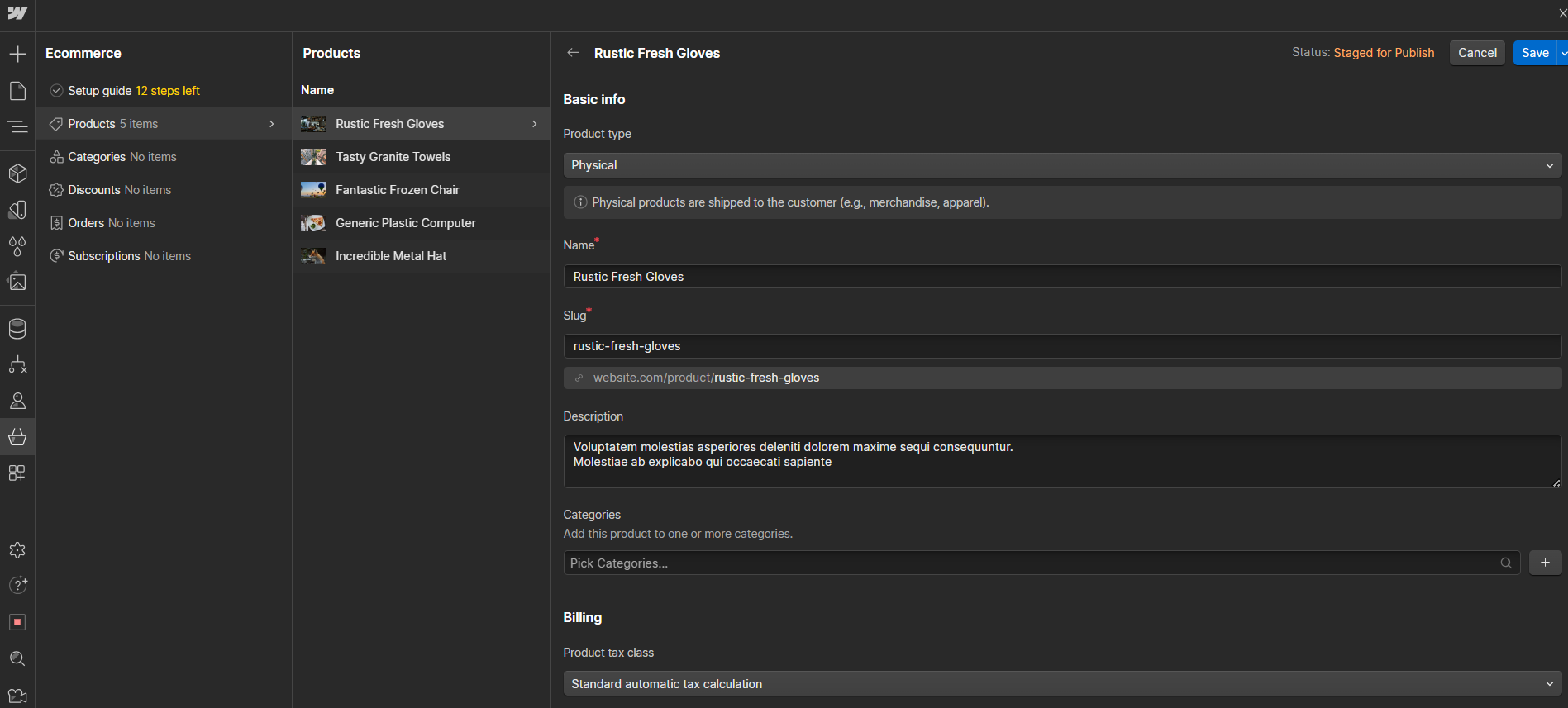
Ecommerce themes & templates
Shopify offers about 150 modern responsive themes for creating a virtual storefront, ensuring a good look on both desktop and mobile devices. While some themes are free, others cost between $170 to $380. In contrast, Webflow offers a diverse range of ecommerce themes and templates designed to cater to various types of online stores, from fashion and technology to artisan crafts and children’s products. Each template comes equipped with built-in ecommerce functionality, allowing you to easily add products and manage your store without the need for coding.
Product page customization
Shopify has a limit of three options per product, totaling 100 unique variations. This limit may not pose a significant constraint, and it is suggested that for products with numerous options, creating separate listings on Shopify can be a more manageable approach. While Shopify offers titles, descriptions, and image galleries with zoom effects, customization options like adding ribbons, size charts, and wishlists are not as straightforward. However, Shopify distinguishes itself with additional features through its extensive library of extra apps, offering functionalities like reviews, Facebook stores, eBay item importers, and a unique Augmented Reality feature for an enhanced customer experience.
On the other hand, Webflow offers extensive customization options for eCommerce product pages, allowing users to design and personalize their pages without coding. It provides tutorials for creating product pages from scratch, offers responsive templates for various devices, and allows users to add custom code and dynamic content using Webflow’s CMS for maximum customization flexibility.
Payment processing
Shopify offers payments with typical charges of 2.9% + 30¢ per online transaction on basic plans, and lower fees for higher-tier plans. However, it adds extra fees for using other payment gateways. Shopify Payments is Shopify’s own payment processing gateway. It allows merchants to accept credit card payments directly on their store without having to integrate third-party payment providers. This simplifies the payment process, reduces transaction fees, and streamlines the handling of finances.
Webflow provides a flexible and secure platform for payment processing and ecommerce through integrations with leading payment gateways like Stripe and PayPal. This allows users to accept a wide range of payments, including credit card transactions directly from their websites. Given the versatility of Stripe and PayPal, businesses can manage online sales efficiently, and these integrations likely support various transaction types, potentially including POS transactions for physical sales environments.
Website Editors
Website EditorsEvaluates the platforms’ website building and editing capabilities.Score Components:
- Customization tools (40%): Range and power of editing features.
- Editor usability (30%): User experience within the editor.
- Design flexibility (20%): Freedom in layout and design changes.
- Update and maintenance ease (10%): Simplicity of updating and maintaining the site.
 7.9
7.9
 9.0
9.0
🏆
Winner: Webflow
. Webflow, with a score of 9.0, is a cloud-based platform that combines web design, CMS, and hosting, enabling users to visually design responsive websites without writing code. It offers a drag-and-drop interface, integrated SEO tools, ecommerce functionalities, and the ability to add animations and interactions, making web development accessible for designers and powerful for developers. Webflow streamlines the process of web creation, from design to launch, offering both high customization and ease of use.
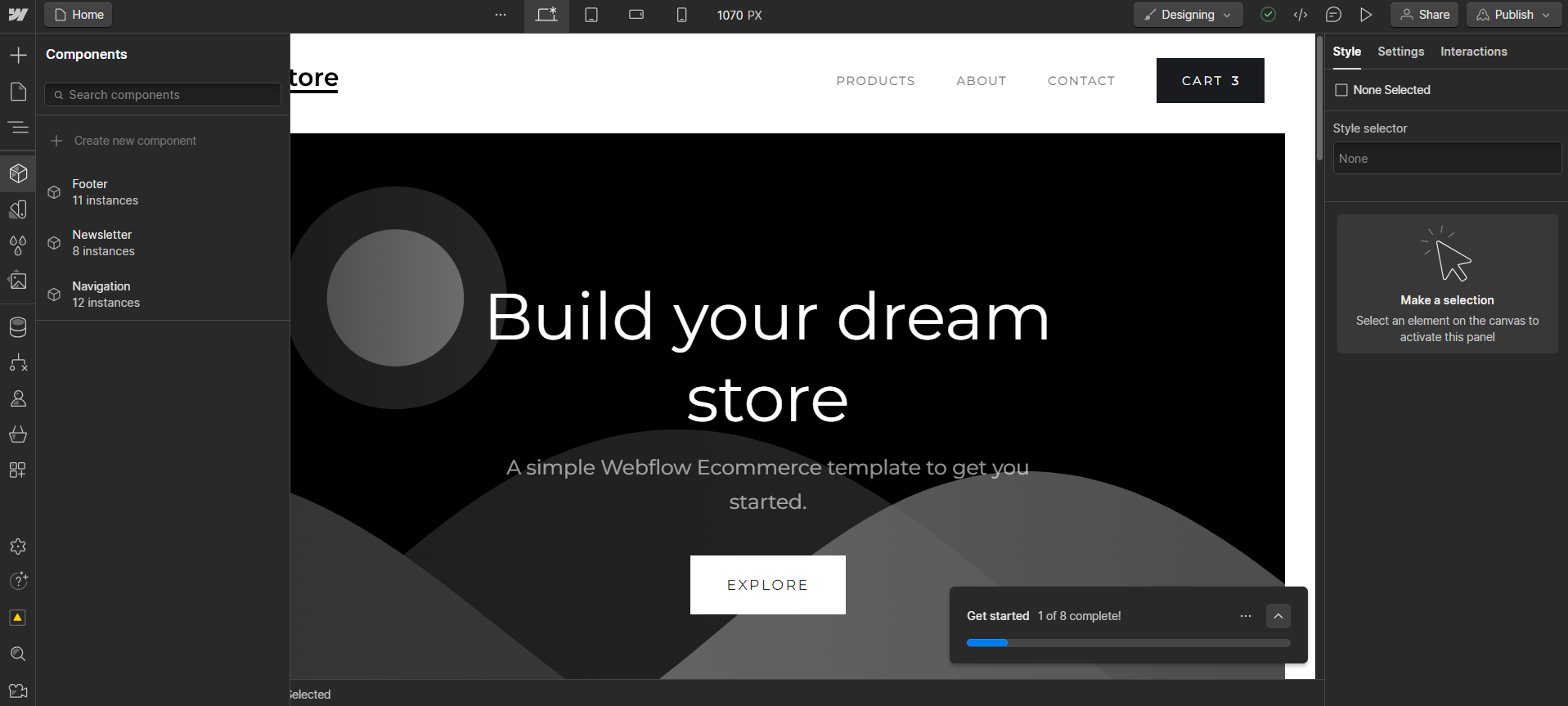
Shopify’s editor, scoring 7.9, excels in providing a streamlined, ecommerce-focused editing experience. It’s particularly beneficial for users who prioritize efficient management of online stores. The editor is straightforward, making it easy to add products, manage inventory, and set up payment methods. While it may not offer the same level of design flexibility as Webflow, Shopify’s editor is optimized for sales and business growth, with built-in tools specifically designed for ecommerce businesses.
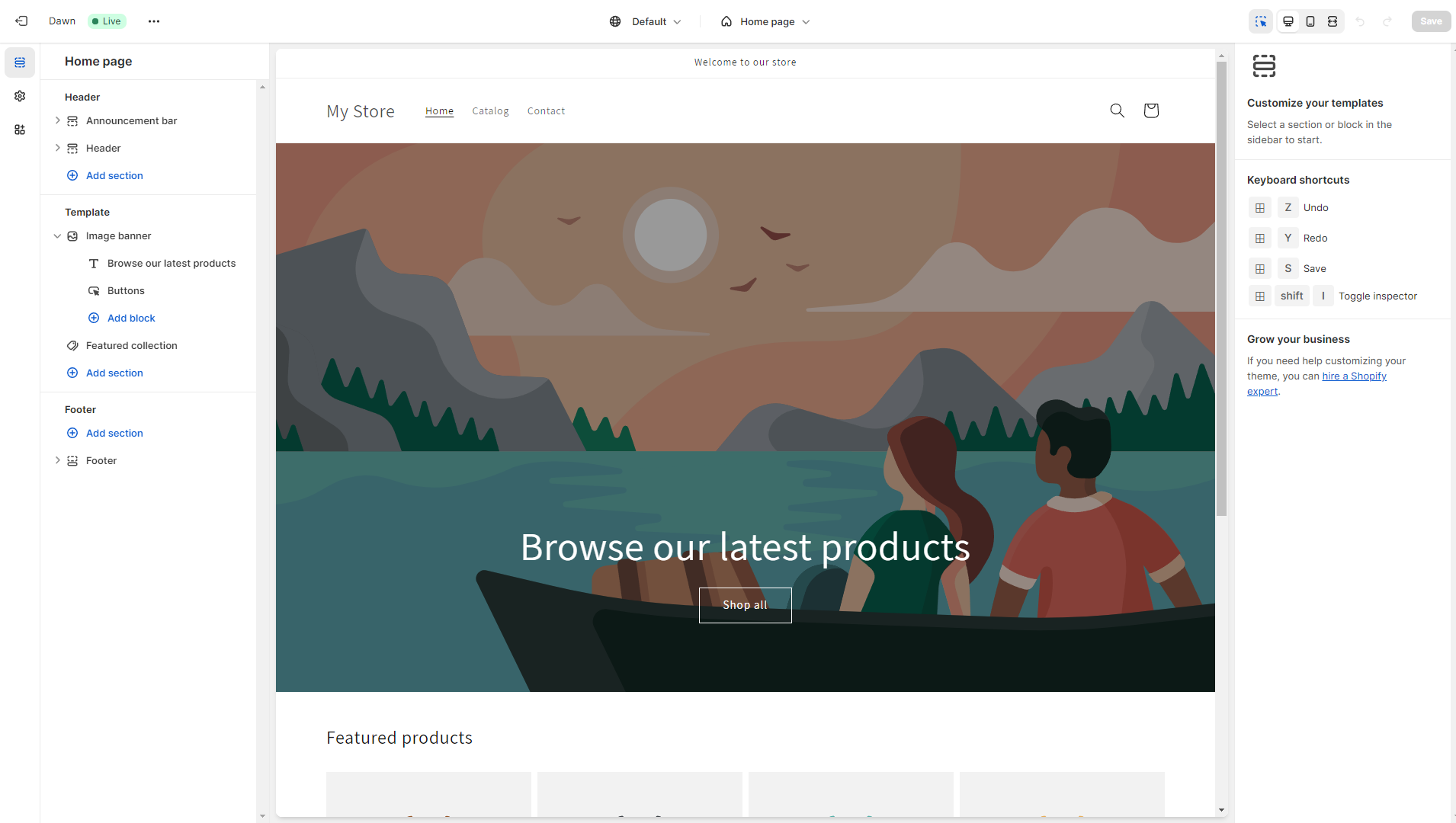
Mobile editor/app
 8.0
8.0
 7.0
7.0
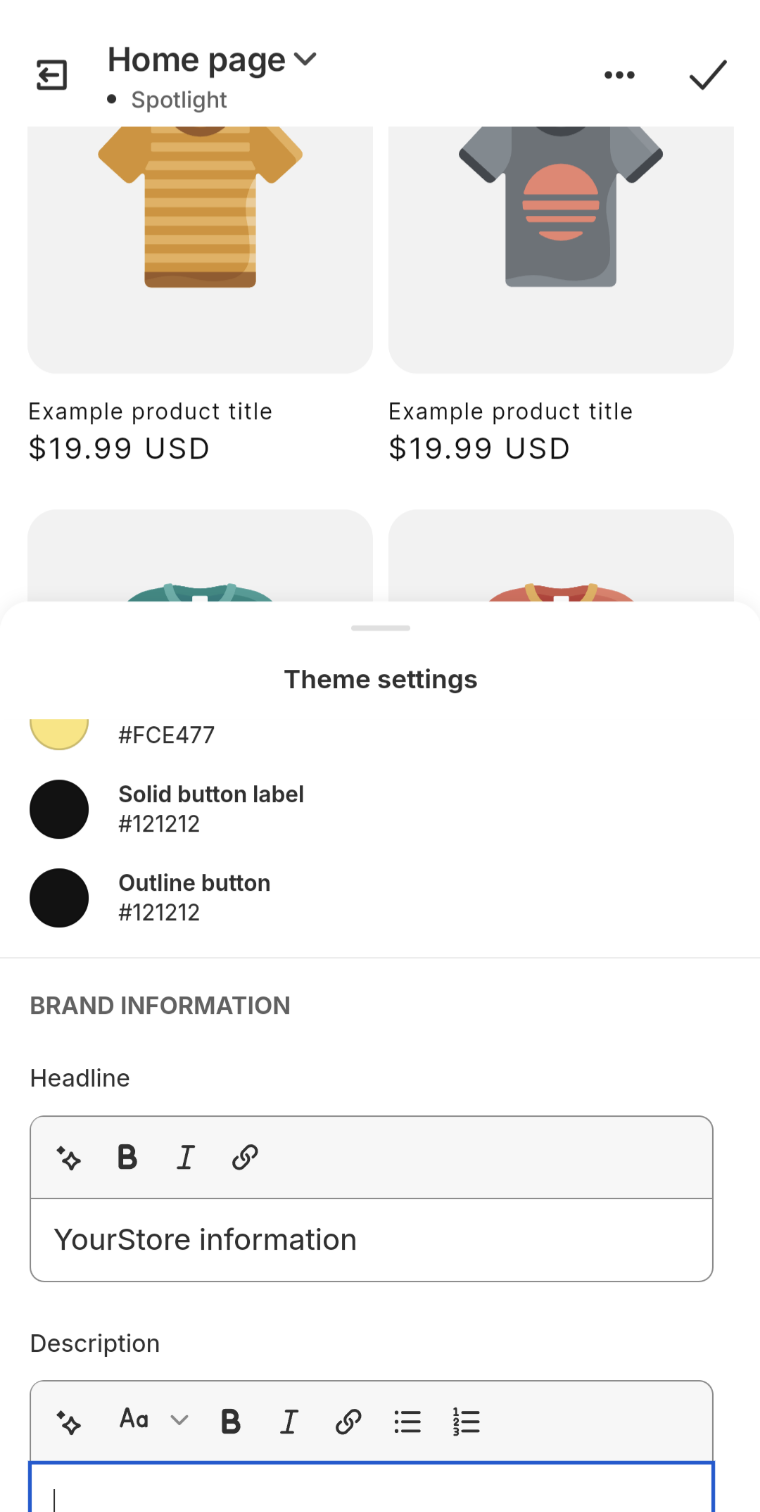
🏆
Winner: Shopify
. Both Shopify and Webflow offer mobile solutions for managing your website, but they cater to different needs and platforms. Shopify’s mobile app includes a user-friendly mobile theme editor that allows users to customize their online store website directly from their mobile device. This feature enables the addition, removal, editing, and rearrangement of content on the store’s website, offering convenient on-the-go adjustments to the store’s appearance and layout.
Webflow, on the other hand, does not have an official mobile editor app. There is a third-party app called EditFlow, created by a community member for Webflow users. However, this app is currently only available for iOS. Therefore, Shopify is the winner in this category due to its higher score and more comprehensive mobile editing capabilities.
Product testing options
Product Testing OptionsAssesses the options for trying out platform features before commitment.Score Components:
- Trial quality (40%): Extent and usefulness of the trial or free version.
- Feature accessibility (30%): How many features are available to test.
- Trial duration (20%): Length of the trial period.
- Ease of transition (10%): Smoothness of moving from trial to paid plans.
 8.1
8.1
 6.3
6.3
Overall Result
:
Shopify wins
. Shopify scores 8.1, offering a 14-day free trial with access to all features, while Webflow scores 6.3, offering a free version with limited features and no trial or money-back guarantee.

|

|
|
|---|---|---|
|
Free Plan |
No (14-day free trial) | Yes (Basic features) |
|
Trial Duration |
14 days | No trial |
|
Testing Premium Features |
All features during free trial |
Limited to basic features in free plan |
|
Money Back Guarantee |
14-day free trial | No |
Price
PriceLooks at the cost-effectiveness and value for money of each platform.Score Components:
- Plan value (40%): What each pricing tier offers.
- Transparency and clarity (30%): Clearness of pricing structures.
- Flexibility of plans (20%): Range of options to suit different budgets.
- Hidden costs (10%): Additional expenses not included in the plan.
 8.2
8.2
 8.0
8.0
Shopify and Webflow both offer a range of pricing options, with Shopify scoring slightly higher in terms of price.
Shopify offers a 20% discount on annual subscriptions, while Webflow offers discounts ranging from 9 to 31% depending on the plan. Both platforms also offer enterprise plans for larger businesses, with Shopify’s starting at $2,000 per month and Webflow’s pricing available upon request.

|

|
|
|---|---|---|
|
Free |
No offering at this amount. |
Starter (Free): Limited features for new sites, including 2 static pages and 50 form submissions lifetime. |
|
$10-$20 |
No offering at this amount. |
Basic ($18/month): Suitable for simple sites with a custom domain, including basic SEO controls and 500 monthly form submissions. And 100 pages. Value for price: 6.5 |
|
$20-$30 |
Shopify Basic ($29/month): Unlimited products, 2.9% + 30¢ card fee with Shopify payments, Extra 2% gateway fee without Shopify Payments, Abandoned cart recovery, Automated sales tax, Digital products, POS Integration, 2 staff accounts. Value for price: 8.0 |
CMS ($29/month): For content-driven sites with 2,000 CMS items, 1,000 monthly form submissions, and full API access. And 150 website pages. Value for price: 7.5 |
|
$40-$45 |
No offering at this amount. |
Standard ($42/month): For new businesses with up to 500 ecommerce items, includes basic ecommerce features, and 2% transaction fee Value for price: 8.5 |
|
$45-$50 |
No offering at this amount. |
Business ($49/month): High traffic capacity, advanced features like site search, and up to 10 content editors. Value for price: 8.0 |
|
$70-$90 |
Shopify Standard ($79/month): Lower card fees (2.6% + 30¢), Gift cards, Professional reports, 5 staff accounts. Value for price: 8.5 |
Plus ($84/month): Higher volume businesses with 0% transaction fees, up to 5,000 ecommerce items, and advanced features. Value for Price: 9.0 |
|
$200+ |
Advanced Shopify ($299/month): Lowest card fees (2.49% + 30¢), Advanced report builder, Real-time carrier shipping, Up to 15 staff accounts Value for price: 8.8 |
Advanced ($235/month): Scalable solution for large online stores with up to 15,000 ecommerce items and the highest caps and 0% transaction fees. Value for Price: 9.5 |
location. As a result in rare cases the prices displayed here can differ from the ones you see on their
websites.
Hosting quality
Hosting
qualityExamines the reliability and performance of the hosting solutions.Score Components:
- Uptime (40%): Consistency and reliability of website availability.
- Speed (30%): Loading times and performance.
- Bandwidth and storage (20%): Sufficiency of resources provided.
- Data centers (10%): Quality and distribution of hosting infrastructure.
 9.0
9.0
 8.9
8.9
Winner: Shopify
. Shopify and Webflow both offer robust hosting services, but Shopify edges out with a slightly higher score. Shopify’s proprietary cloud-based hosting, global data centers, and guaranteed uptime for all plans make it a reliable choice for businesses of all sizes. Webflow, while offering managed hosting and a globally distributed network of data centers, only guarantees uptime for its Enterprise plan.

|

|
|
|---|---|---|
|
Do they offer hosting? |
Yes, included in all paid plans |
Yes, included in all paid plans |
|
Data Centers: |
5 globally: USA (Ashburn, Virginia; Santa Clara, California), Canada (Toronto, Ontario), Ireland (Dublin), and Singapore |
Webflow doesn’t actually have its own data centers. Instead, it relies on a globally distributed network of data centers from Amazon Web Services (AWS) and Fastly. |
|
Type of hosting: |
Proprietary cloud-based hosting |
Managed Hosting |
|
Uptime: |
99.99% |
99.99% |
|
Uptime Guarantee: |
Yes, 99.99% |
Only Enterprise plan, 99.99% |
Website Speed Optimization
Website Speed OptimizationEvaluates optimization of website loading timesScore Components:
- PageSpeed Score (30%): Google’s score indicating performance optimization.
- Loading Time (30%): The average time until a website is fully interactive.
- Mobile Optimization (15%): Optimization effectiveness for mobile devices.
- Resource Optimization (15%): Optimizing images, scripts, and other heavy resources.
- CDN Usage (10%): Use of CDN to enhance speed across geolocations.
 7.8
7.8
 8.1
8.1
🏆 Winner: Webflow
Both Shopify and Webflow prioritize website performance and page speed, but Webflow edges out Shopify with a higher Website Speed Optimization score.

|

|
|
|---|---|---|
|
Focus |
App optimization, Google AMP |
Custom Cache Settings, Custom Element Lazy Loading, Automatic Minification, Responsive templates, CDN |
|
Performance Tools |
Google Lighthouse, PageSpeed Insights |
Google PageSpeed Insights Integration |
|
Key Strategies |
App efficiency, Theme optimization |
Custom Cache Settings, Custom Element Lazy Loading, Automatic Minification, Responsive templates, CDN |
|
Load Times |
Varies widely, dependent on optimization |
Below 2 seconds average |
|
Page Speed Scores Range |
Scores vary; influenced by apps, images |
77.2/100 |
|
Core Web Vitals Improvement |
Emphasis on LCP, FID, CLS improvements |
Improving components’ usability, and emphasis on LCP, FID and CLS |
Webflow’s approach to website speed optimization includes custom cache settings, custom element lazy loading, automatic minification, responsive templates, and a content delivery network (CDN). This comprehensive strategy results in an average load time of below 2 seconds and a PageSpeed score of 77.2/100. Webflow also focuses on improving components’ usability and the Core Web Vitals (LCP, FID, and CLS).
On the other hand, Shopify’s strategy for speed optimization includes app efficiency and theme optimization. However, its load times and PageSpeed scores vary widely, depending on optimization. Shopify also emphasizes improvements in the Core Web Vitals (LCP, FID, and CLS).
Get a head start on website creation with AI
Create a custom website tailored to your business needs 10X faster with 10Web AI Website Builder!
Plugins and integrations
Plugins and integrationsMeasures the range and effectiveness of additional plugins and integrations.Score Components:
- Variety of options (40%): Range of available add-ons.
- Integration smoothness (30%): Ease of integrating plugins into the site.
- Quality of plugins (20%): Functionality and reliability of the options.
- Custom integration capabilities (10%): Support for custom or third-party integrations.
 8.7
8.7
 5.5
5.5
🏆 Winner: Shopify.
With a score of 8.7, Shopify outperforms Webflow, which scores 5.5. Shopify offers over 8,000 apps in its App Store, covering a wide range of functionalities. These apps come with various pricing options, including free, paid, freemium, and one-time payment models. Shopify plugins and integrations enhance ecommerce by offering advanced sales, marketing, and payment options, streamlined shipping, sophisticated inventory management, improved customer service, in-depth analytics, seamless accounting integration, creative store design, mobile app support, enhanced security, multi-channel selling, product review tools, dropshipping and print-on-demand support, language localization, and accessibility improvements. Key Shopify integrations feature Oberlo for dropshipping, Klaviyo for email marketing, Yotpo for reviews, Printful for print-on-demand, Shopify POS for sales, Google Analytics for insights, Facebook Channel for social selling, ShipStation for shipping, QuickBooks for accounting, Privy for conversions, Smile.io for loyalty, SEO Manager, AfterShip for tracking, Spocket for products, and Gorgias for customer service, enhancing various ecommerce aspects.
On the other hand, Webflow doesn’t have plugins or extensions in the traditional sense. Instead, it offers a built-in library of website elements and functionalities that you can use to create your website. This library is constantly being expanded, so you’ll always have access to the latest features and tools. However, Webflow does integrate with a number of third-party services and tools that can add even more functionality to your website. These integrations are not managed by Webflow, so the number of available options and their pricing structures can vary depending on the specific tools you choose. Webflow’s extensibility through plugins allows for enhancements across ecommerce, SEO, analytics, form building, social media integration, and more. These tools can improve user engagement, site performance, security, and accessibility, along with providing advanced content management and marketing capabilities. Essentially, plugins can significantly expand the functionality of a Webflow site, making it more interactive, user-friendly, and tailored to specific business needs. Webflow offers a diverse range of integrations categorized by function, including Marketing & Analytics tools like Zapier, Google Analytics, and Hotjar; Forms & Lead Capture solutions such as Typeform, Wufoo, and Gravity Forms; Ecommerce platforms like Shopify, Stripe, and Gumroad; Live Chat & Support options such as Intercom, Drift, and Crisp; and a variety of Others like Airtable, Notion, and Forestry. These integrations cater to different needs and goals, providing flexibility and efficiency for Webflow users.
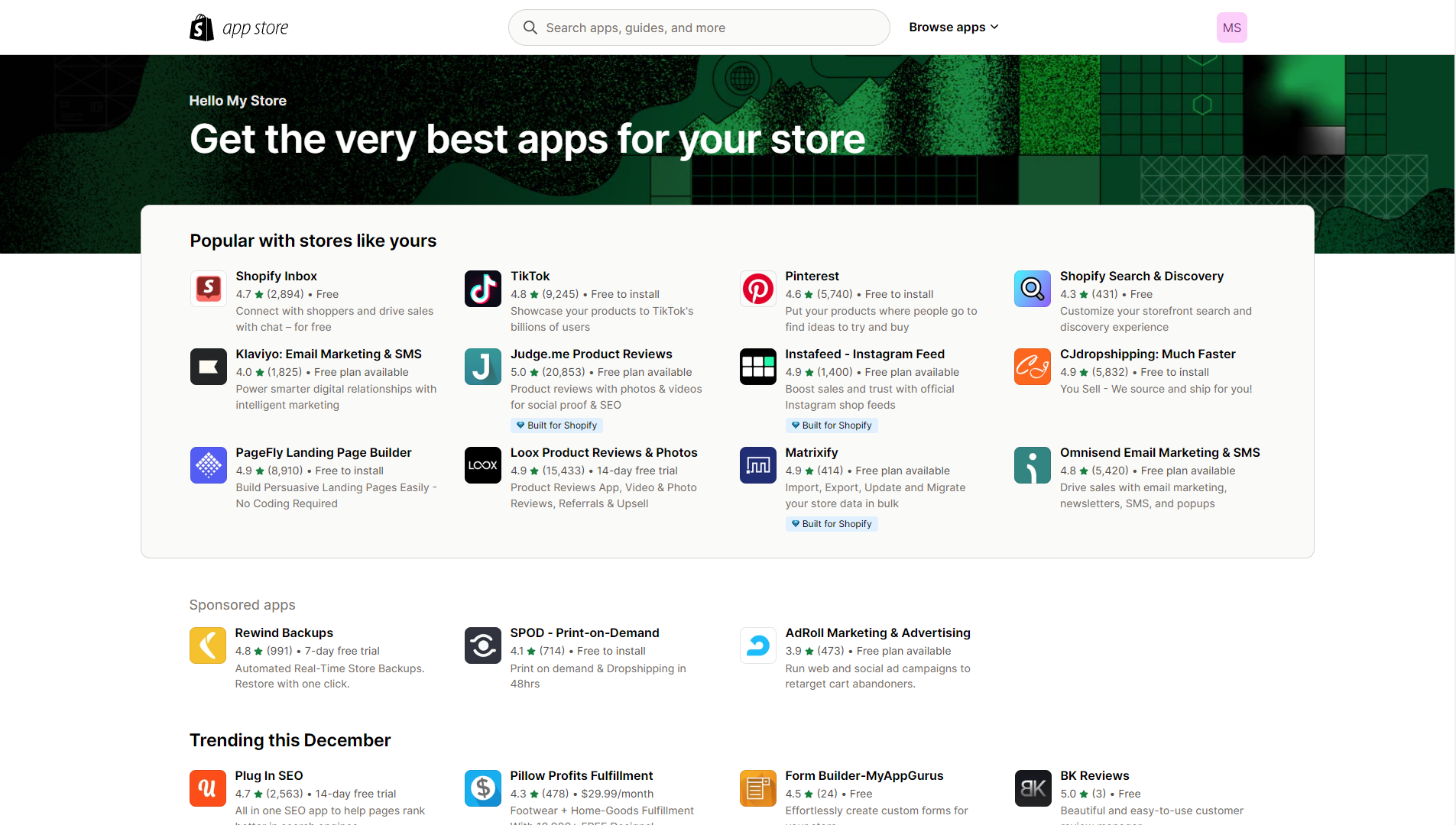
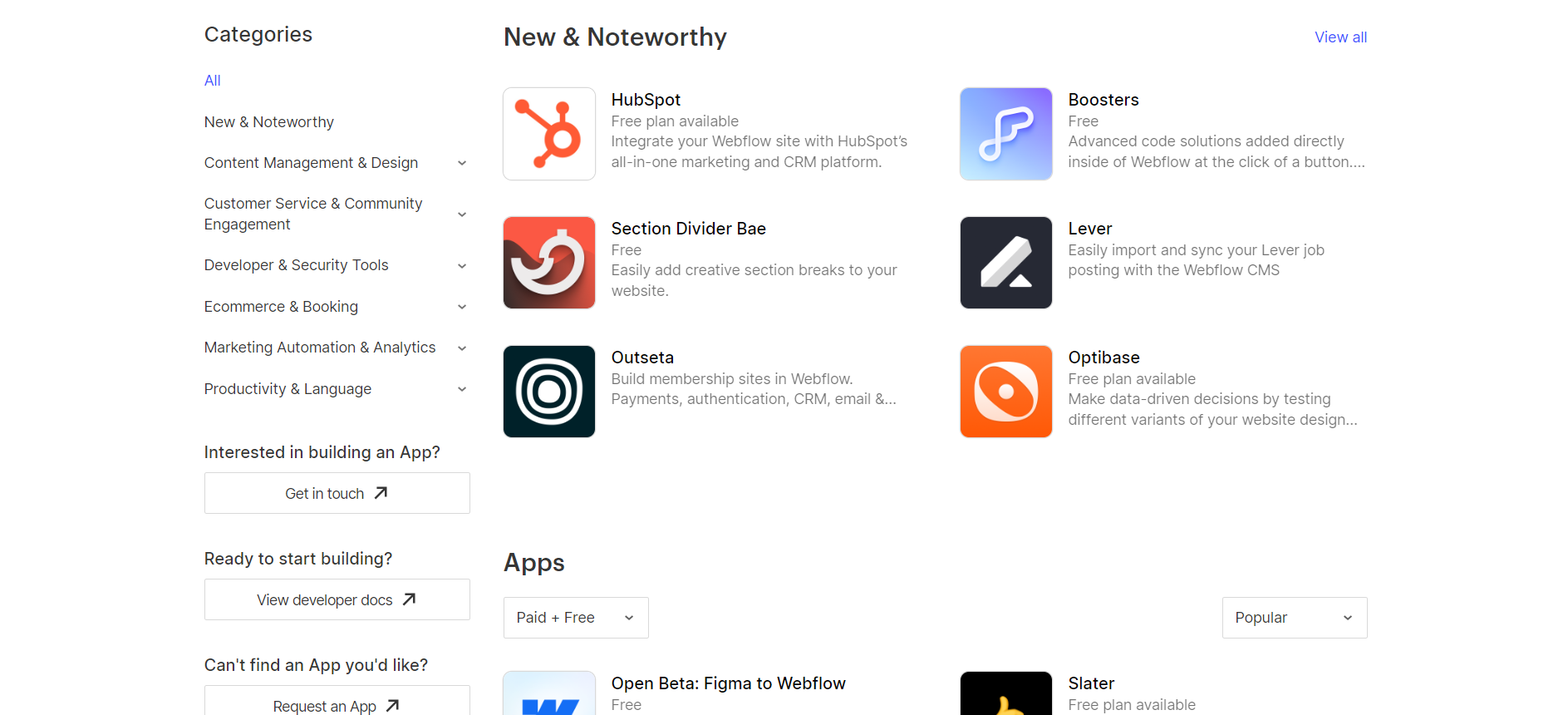
Marketing Features
Design FunctionalitiesRepresents how well each platform allows for creative design and customization of websites.Score Components:
- Template Variety (30%): Range and quality of design templates.
- Customization (30%): Flexibility and options for design alterations.
- User Interface (20%): Ease and intuitiveness of the design process.
- Responsiveness (10%): Adaptability to different devices and screen sizes.
- Innovation (10%): Unique design features and tools.
 8.8
8.8
 7.8
7.8
🏆
Overall Winner: Shopify
. Shopify stands out for its more advanced ecommerce-focused marketing tools, especially in analytics and ad campaign management. Webflow, while offering a robust set of marketing tools, is more suited for content-driven strategies and simpler social media engagement.

|

|
|
|---|---|---|
|
SEO Tools |
|
|
|
Email Marketing |
|
|
|
Blogging |
|
|
|
Social Media Integration |
Advanced integration for selling directly on social platforms |
Simplifies content sharing and audience engagement |
|
Analytics and Reporting |
Detailed analytics for in-depth insights |
Integrates with Google Analytics for comprehensive analysis |
|
Ads and Promotions |
Google Ads integration; sophisticated ad campaign management |
Supports ad and promotion management through integration with platforms like Google Optimize |
Customer Support
Customer supportEvaluates the quality and availability of support options.Score Components:
- Response time (40%): Speed of support responses.
- Support quality (30%): Effectiveness and helpfulness of the support.
- Availability (20%): Range of support channels (phone, chat, email).
- Resource richness (10%): Quality of self-help and educational materials.
 8.6
8.6
 8.3
8.3
🏆 Winner: Shopify
. When comparing Shopify vs Webflow, Shopify takes the lead in customer support with a score of 8.6. Shopify offers 24/7 support through chat, email, and phone, ensuring that users can get help whenever they need it. The platform also provides clear tutorials, an extensive community forum, and a valuable marketing blog, making it easier for users to find solutions and grow their businesses.
Webflow, with a customer support score of 8.3, also offers robust support options, including 24/7 live chat, email, and a community forum. Webflow’s extensive documentation and video tutorials are particularly helpful for users navigating the platform. For enterprise customers, Webflow provides a dedicated Customer Success Manager and priority support, ensuring that large organizations receive the assistance they need.
Overall, while both platforms offer excellent support, Shopify’s round-the-clock availability and comprehensive resources give it a slight edge over Webflow.
Security
SecurityLooks at the platforms’ security measures and data protection.Score Components:
- Data protection (40%): Safeguards for user and customer data.
- SSL and encryption (30%): Implementation of secure connections.
- Compliance (20%): Adherence to industry security standards.
- Regular updates (10%): Frequency of security updates and patches.
 9.0
9.0
 7.8
7.8
🏆
Winner: Shopify
. Shopify’s security measures are more comprehensive, with a focus on data privacy, secure infrastructure, encryption, and limited access. They also comply with data privacy regulations, practice data minimization, and ensure user control and transparency. Additional security measures include two-factor authentication, regular audits, and a dedicated incident response team.
Webflow also prioritizes security, implementing robust encryption techniques and strict access controls. They regularly update their systems and conduct audits to identify and address any potential vulnerabilities. However, Shopify’s higher security score and more extensive security measures give it the edge in this category.
AI Capabilities
AI capabilitiesMeasures the effectiveness of AI-driven features and tools.Score Components:
- Automation efficiency (40%): Impact of AI on streamlining processes.
- Personalization (30%): AI-driven customization for users or customers.
- AI-Assisted design (20%): Role of AI in website design and functionality.
- Data analysis (10%): Use of AI in interpreting user data and analytics.
 7.9
7.9
 8.3
8.3

|

|
|
|---|---|---|
|
Personalized Design |
|
AI-customized templates (announced, not yet available) |
|
SEO Optimization |
AI-driven recommendations for better search engine visibility |
|
|
Customer Behavior Analysis |
Advanced analytics to understand customer preferences |
AI-powered content personalization (announced, not yet available) |
|
Sales Predictions |
AI-powered sales forecasting tools |
|
|
Inventory Management |
AI tools to assist in efficient inventory handling |
|
|
Content Generation |
AI-assisted content creation |
|
🏆 Winner: Shopify
. Shopify, with a score of 7.9, utilizes AI mainly to enhance the ecommerce experience. Its AI features focus on customer behavior analysis, personalized shopping experiences, inventory management, and sales predictions. While Shopify’s AI is powerful, it is more business and data-centric.
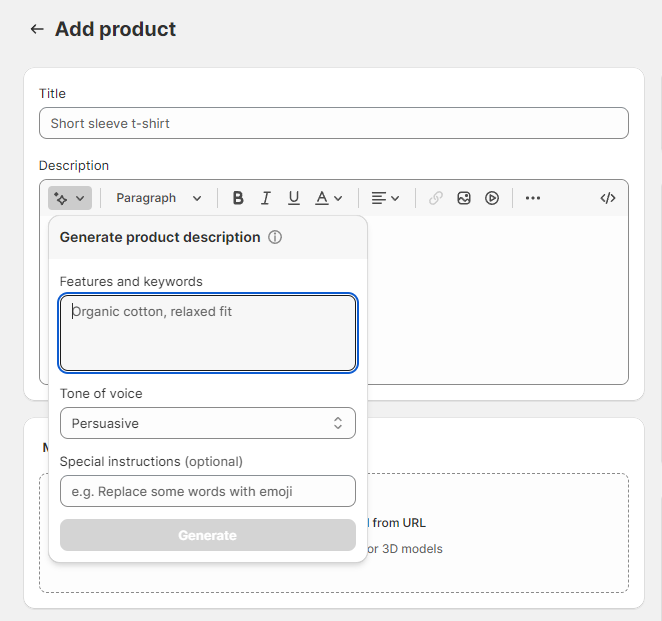
Webflow, with a score of 8.3, does not currently have AI capabilities. However, they have announced plans to introduce AI features in the future, including AI-customized templates and AI-powered content personalization. These features, once implemented, could significantly enhance the user experience on Webflow.
User Management
User ManagementAssesses the platforms’ capabilities in managing user roles, permissions, and accessibility.Score Components:
- Role Customization (40%): Flexibility in creating and defining user roles and
permissions. - Ease of Management (30%): User interface and tools for managing users.
- Access Control (20%): Effectiveness of access control measures for different user
levels. - Scalability (10%): Ability to manage a growing number of users efficiently.
 6.5
6.5
 8.3
8.3
🏆 Winner: Webflow
. Managing your online team with Shopify and Webflow involves different approaches to website editing access.
-
Shopify enforces staff account limits based on plans, ranging from 2 to 15, with Shopify Plus offering unlimited
accounts. Collaborators with limited access are also an option. - In Webflow, the number of users who can edit a website and their access levels vary by plan. Core, Growth, and Enterprise plans offer unlimited editors, while others limit content editors to 3 or 10 per site. Access levels include Designer for full access and Editor for content editing. Workspace roles like Admin, Designer, and Editor ensure collaboration and security through features like the Site Activity Log and role-based permissions.
Shopify User Roles and Access Levels:
| Role | Description | Access Highlights |
|---|---|---|
| Store Owner | Full control over store | Manage products, orders, discounts, payments, apps, settings. Create and manage staff accounts. |
| Staff | Configurable access by owner |
Add/edit products, manage orders, fulfill orders, manage customers, update content. Access level can be customized by the owner. |
| Collaborator | Limited access for external partners | View and manage specific sections like blog or product categories. Cannot access full store settings. |
Webflow User Roles and Access Levels:
| Role | Description | Access Highlights |
|---|---|---|
| Workspace Owner | Full control over Workspace settings and member management. | Edit settings, manage billing, access/edit all sites, invite/remove members, manage permissions. |
| Workspace Admin | Similar to the owner with some restrictions. | Edit settings, manage billing, access/edit all sites, invite/remove members (except owner), manage permissions. |
| Workspace Member | Limited control focused on site interaction. | Download invoices, access/edit sites, invite members. |
| Workspace Guest | Temporary collaborators with limited access. | Access/edit sites. |
| Workspace Commenter | Limited to commenting for feedback on sites. | Create/view/resolve comments, preview sites. |
| Site Admin | Full control at the site level. | Manage permissions, delete/transfer sites, billing management, design and publish changes. |
| Can Design | Design capabilities with some restrictions on publishing. | Design in Designer, create/modify classes and components, publish changes with permission. |
| Can Design (Limited) | Restricted design capabilities for Enterprise customers. | Create new classes, modify created classes, limited publishing capabilities. |
| Can Edit | Content editing without full design privileges. | Edit text/links/images, manage assets, publish Collection items and Ecommerce products. |
| Can Comment (Site Level) | Commenting for feedback at the site level. | Create/view/resolve comments, preview sites. |
Additional Features

|

|
|
|---|---|---|
|
SSL Certificate |
|
|
|
Custom Domain |
|
|
|
Free Custom Domain Included |
|
|
|
International Domains |
|
|
|
Mobile Responsive |
|
|
|
Page Speed |
|
|
|
Website Builder Mobile App |
|
|
|
Convert a Website To An App |
|
|
|
Website Analytics |
|
|
|
Multilingual Sites |
|
|
|
Multiple Users |
|
|
Shopify vs Webflow: User Feedback
Shopify’s slightly higher rating on G2 Crowd can be largely attributed to its specialization in ecommerce. Its comprehensive features, ease of use, and robust customer support cater specifically to online businesses, leading to high user satisfaction among those seeking a dedicated ecommerce solution.
Webflow receives high praise for its user-friendly interface, eliminating the need for coding while offering extensive design flexibility. Users appreciate its scalability, cost-effectiveness, and seamless integration of essential features like forms and CMS. However, some users note a slight learning curve and occasional limitations, particularly in ecommerce functionalities and content management. Overall, Webflow proves to be a powerful tool for building and managing websites, offering robust features for both beginners and experienced developers, albeit with some room for improvement in certain areas like collaborative editing and content management.
The making of this blog
We followed a clear, step-by-step process to write and research this article.
Shopify vs Webflow: FAQ
Which platform is better for ecommerce, Shopify or Webflow?
Can I build a custom, responsive website without coding knowledge on Shopify or Webflow?
Which platform offers better support for beginners?
How do Shopify and Webflow compare in terms of design functionalities and templates?
Which platform is more affordable, Shopify or Webflow?
In terms of hosting quality and website speed optimization, which platform is better?
Which platform offers better customer support?










